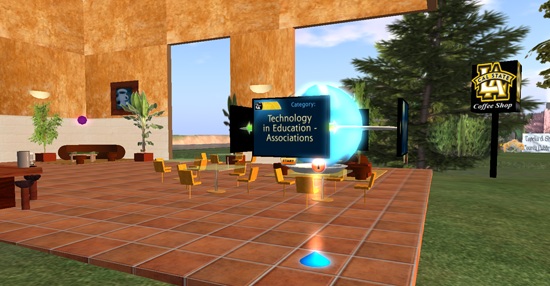Kitely — an OpenSim-based grid that runs its regions in the Amazon cloud — has a unique system that gives educators some interesting capabilities and advantages.
To appreciate those features that are most beneficial requires just a bit of imagination and I have drawn on my perspective of having been involved in virtual worlds as both an educator and student.
My first experience with virtual worlds was in Second Life, as part of a graduate program in new media at California State University Los Angeles (CSULA). The professor, Dr. Penelope Semrau, had written annual grants, which provided for a parcel in Second Life. The process of grant writing is never easy and awards are never guaranteed.
In explaining why she decided to discontinue teaching in Second Life, she told me, “I would have to continually write grant proposals to support the costs of the lease, which was extra work for me year after year.”

I not only took Dr. Semrau’s class, but became her teaching assistant a year later. I became keenly aware of the challenges the students faced as we worked together to find solutions. The students had an allotment of 35 prims each to build their projects, so it took some tremendous creativity to realize their design goals.
But cost and prim limitations weren’t the only problems Dr. Semrau had with teaching in Second Life.
“I didn’t particularly care for the concept of ‘real estate’,” she said, “Because it promotes a capitalist form of thinking on its users of buying and selling and bigger is better, which didn’t reinforce the nature and philosophy of my course about teaching and learning in a virtual world.â€

Kitely advantages at a glance
This is where I think the hosting model of Kitely has real potential.
Kitely promotes a concept of “worlds†and identifies the acquisition of virtual space as a function of time rather than ownership. This contrasts with the terminology of “buying land†which is tied to parcel size and prim count.
Besides the idea of paying only for the services used, the hourly rate at Kitely is quite modest and offers low-cost opportunities under relevant circumstances. Kitely even has a “Free Plan†that permits a user to have access to the platform for two hours a month at no charge. This could be especially economical for users that build regions on their local computer and upload them when ready for sharing.
As for the costs of sharing, those costs can also be distributed to the visitors using the Kitely pricing mechanism. As an illustration: instead of the professor acquiring and paying $150 dollars per class for hosting and sim access, 30 students pay $5 each via Kitely credits. [Ed: Kitely $5 a month plan comes with two free regions, and up to 25 hours of monthly access.] There are also savings over breaks, summer vacations and so on, when use drops off — remember that Kitely charges primarily based on time, not space.
You also get OAR uploads and exports. Easy, self-service. Fantastic. And a detailed activity history with time, date, user and duration. This gives the educator and the student verification of activity time.
Kitely also has a directory of worlds, rather than a common entry region. One issue for educators is the new user experience, which can be troublesome in Second Life.
“When logging in as a newbie, students would be confronted by outrageous strangers on the welcome island which I found disgusting,” said Dr. Semrau.
Kitely provides a mechanism whereby worlds have descriptions and are entered directly as discrete regions. To see how this works, visit our Serenity Island region on Kitely.
Although Kitely regions don’t have dedicated servers but instead run in the Amazon cloud, they run very well. Checking for sim FPS and ping sim values as I write this, I get exactly the same values in my Kitely World as in Second Life: Sim FPS: 45; Ping sim: 39-58msec.
More land for the same price
Additional to those points listed above, Kitely allows for two further opportunities that can especially add value for the students.
In the first place, since Kitely Worlds are billed by time, each student can afford to have his or her own entire region for no more than the cost of using a single shared region. This allows for greatly expanded project opportunities and boundaries.
In many cases, students want to manipulate region settings, or spread a project out to give the proper scale, and so on. Using the appropriate Kitely billing method, the students can easily visit each other’s sims without imposing additional costs on the sim creator.
Secondly, projects can be saved, not only as downloaded OAR files, but also as files at Kitely, ready to be launched at a moment’s notice. The professor can archive the work of several classes on Kitely for future demonstrations, yet pay only ten cents per region per month, or $1.20 per year per region. Students can do this as well for their own purposes.
Finding the best fit and value
Naturally, there is no service that works best for every purpose and every user. Only time will reveal and confirm the best markets for the Kitely approach.
Still, for education, the unique features of Kitely Virtual Worlds on Demand warrant consideration by educators with little or no funding as well as those those looking for a service that offers some unique facilitation features and a highly affordable on-demand opportunity for students to maximize the value of their short-term involvements in sim-based classes.
- Virtual curating frees artist - April 16, 2024
- Apple and the bane of VR gentrification - February 3, 2024
- Net neutrality is dead. Why that’s bad for OpenSim grids - December 16, 2017
